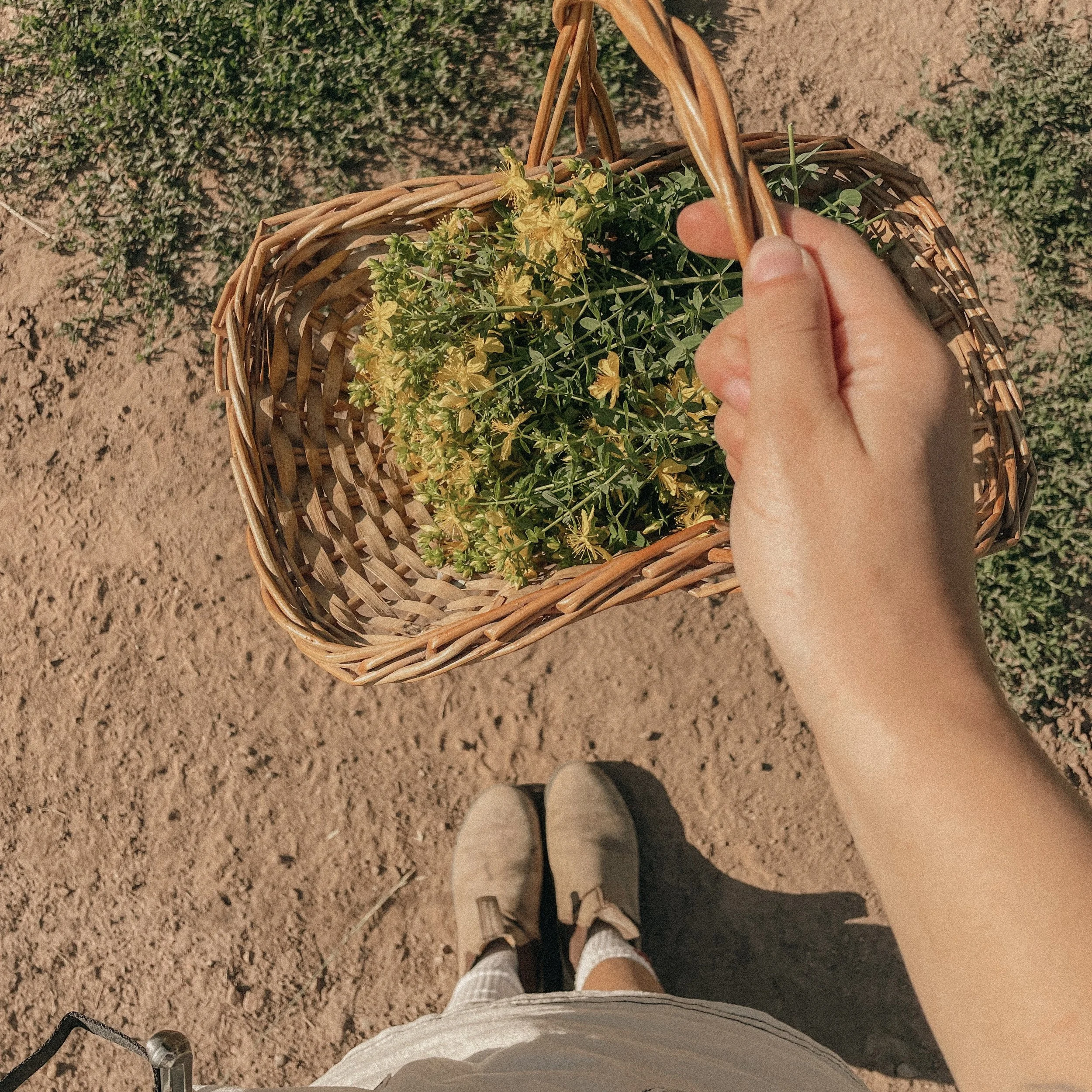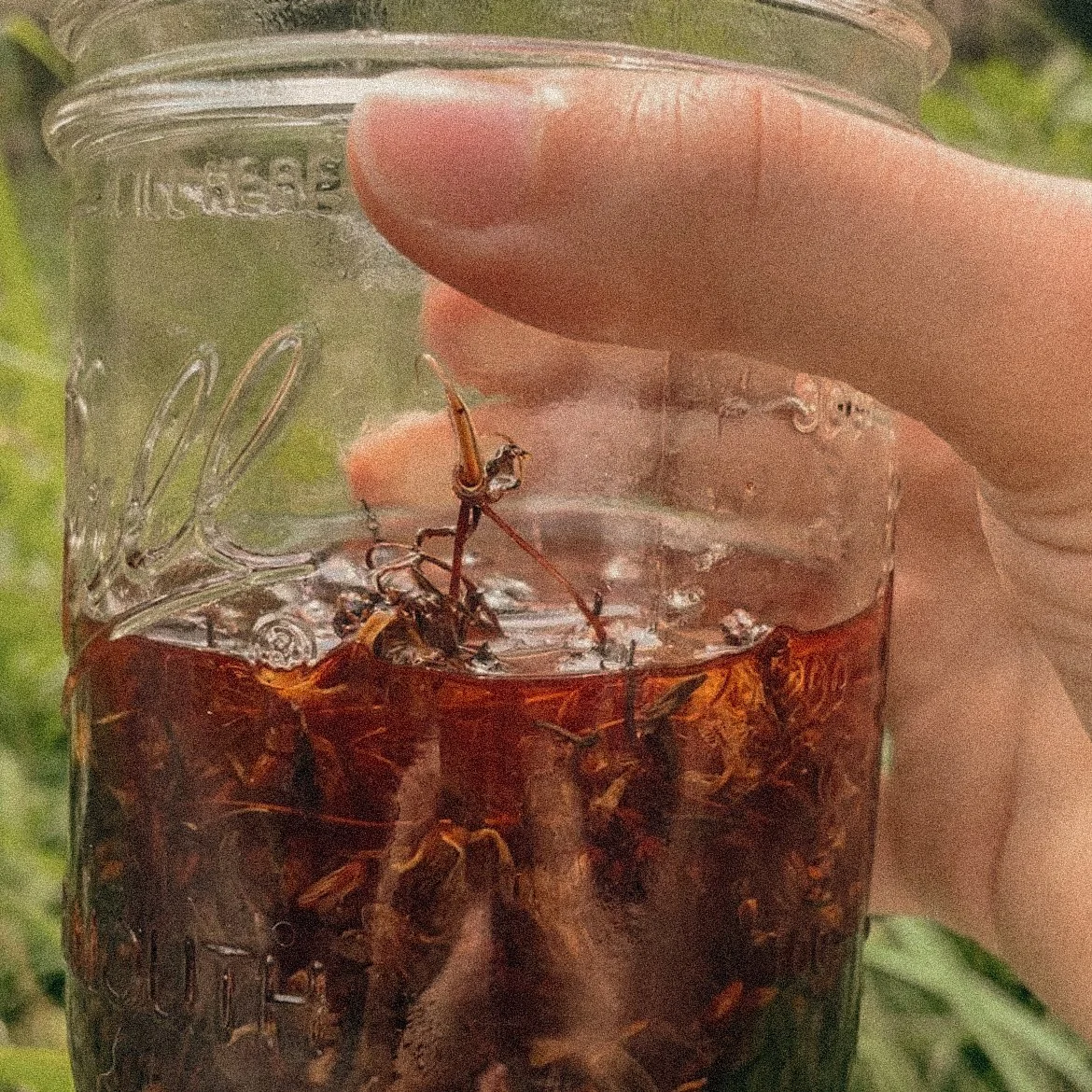how to make a fresh st. john’s wort oil
When I finally got to sit with a huge stand of St. John’s Wort in South Dakota, I was thrilled. I was like a little girl sitting under a collage of golden umbrellas, their petals standing tall and upright towards the sky.
I’ve always been struck by their many stamens. This is key to identifying a handful of plant families, one of them being the Hypericaceae family, which St. John’s Wort is a member of.
St. John’s Wort’s species name, perforatum, refers to the punctures, or holes, in their leaves. These are visible when held up to the sunlight.
perforations in the leaves
In addition to this, you know you’re with the right plant and they’re ready to harvest when you press the buds between your fingertips and a deep, red pigment oozes.
red/purple pigment from the buds and flowering tops
I don’t work with fresh plant material all that often. There are a whole host of issues with wildcrafting and foraging, and there is a proper and respectful way to do so, which are to be discussed at another time. If it is available to you, grow St. John’s Wort in your garden, visit a friend that does, or have a chat with the ecologists/botanists/park service employees/etc. on the status of the plants in your area and their relationship to the ecosystem.
*This is not a guide to harvesting St. John’s Wort, but rather how to work with fresh plant material to craft an oil.
On St. John’s Wort’s Signature + Benefits of Topical Application
St. John's Wort typically blooms around the time of the Summer Solstice, signifying their profound devotion to the Sun and knowledge of when the right time for pollination is. They unfold all of their petals in unison under the Sun's heightened presence on our Earth.
Their connection with the Sun contributes to their a solar, masculine energy, conjuring glow and innocence in ones spirit. And their essence sheds this same confidence of being in counsel with the Sun.
This relationship is present as we apply St. John's Wort to our bodies. Internally, the hypericin content (that red exudate from the fresh plant!) has been noted to cause photosensitivity. Though externally, the plant is known to protect against UV.
I harvested the flowering tops a bit later in the season, though a scarlet red was still exuded from the buds when I pressed on them.
Though this preparation is not for internal use, I made a fresh oil to be utilized as first aid care for nerve pain and minor wound healing (scrapes, abrasions), for defense against excess Sun exposure (with proper sunscreen), and as a spiritual shield.
How to Make Your Oil
With your fresh plant, you’ll want to slightly dry the material to allow some of the water content to be released. Generally, any water in oil makes it vulnerable to the formation of mold, so taking the time for gentle drying is important. With St. John’s Wort, you don’t want to dry the plant material too significantly, so the red pigment (the medicine) is preserved through this process. There are a few ways to do this, and I truly think it’s up to your personal preference of how. You could:
Let it wilt for a few hours to overnight on an old, clean sheet, a drying rack, or a surface with some sort of ventilation.
Place it on and cover with an old, clean sheet in the back of your car for a few hours to overnight. This is a trick Herbalist Julie James taught me, and it works like a charm. It’s my favorite method! In my case, this ended up being about a two day process because the plant material wasn’t dried to my liking as I was traveling through some damp states. The climate in which you reside is good to consider.
Once the plant material is semi-dry/wilted, break up the plant material and place it into a clean (sterile) glass jar, then cover with your choice of oil. I prefer fractionated coconut oil. Other options could include: jojoba, almond, or olive oil. The plant material should be covered by at least 1-inch.
Cover the jar with parchment paper and a lid.
You’ll then want to label with the date, common and latin name of the plant, and type of oil you used.
Place in a sunny window to infuse for 2-3 weeks. Your oil make take a few days to change color.
When the process is complete, strain and press with a paint straining bag, muslin cloth bag, or cheesecloth. Let decant (sit) overnight, then pour off the oil so that any leftover plant material is left on the bottom.
And voila! Make into a salve or simply apply directly to the body.
finished product before pressing





